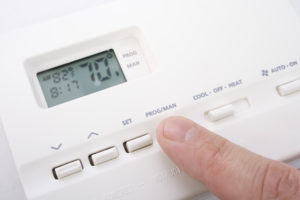
Winter is coming, and that means it’s time to talk about not only heating but heat retention.
Those of us in colder climates have probably experienced less-than-adequate heating at home, whether in an owned home or a rented one. There can be a few different causes for a draft in your house, and usually, it’s a combination of them. Let’s take a look at what might be contributing to that indoor chill, and what we can do to turn up the heat and keep the cold out.
Your HVAC System
Most modern, freestanding homes are equipped with a central Heating, Ventilation, and Air Conditioning system, or HVAC. This refers to your air conditioning unit, your furnace, and the system of ducts that facilitate the delivery of air throughout the house.
When winter rolls around, you might find you’re not so satisfied with the performance of your HVAC. But don’t be so quick to shop around for upgrades; you probably just need to tinker a little. First, make sure none of your home’s registers, or vents, are being blocked in any way, to ensure you’re getting the best survey of airflow. If it feels too weak, go to the source: your furnace.
A furnace breathes hot air into a central supply plenum, which then distributes the air throughout the ductwork. Take a look at your furnace’s air filter, and don’t be surprised if it’s utterly blackened and badly in need of replacement. A new filter should result in a noticeable increase in the flow of hot air, and the quality of that air will also be better.
Next, adjust your dampers. The ducts fed by the central supply plenum will most likely be outfitted with dampers, which constrict the flow of air and are meant to be adjusted as seasonal needs change. If you’re getting weak airflow, your dampers may be in the wrong position. Open them up, and mark their position for winter, if it’s not marked already.
Radiators & Heaters
Many apartments and older homes will lack a central forced-air system for heating, featuring instead steam- or hot water-fed radiators. Radiators are generally quite good at heating, especially in smaller living spaces, but improper use can diminish their effectiveness.
Radiators should be free from any blockage from furniture or decor, since they rely on contact with the air to distribute heat. Your radiator should have open air around it, and not be covered, unless by a purpose-made radiator cover that allows adequate ventilation. If your radiator seems to not be producing enough heat, it may need to release some trapped air; toward the top of the radiator, you should see a release valve, which can be slowly opened to release air. Close the valve again when you notice steam or water being released.
If your radiators still aren’t satisfying you, you don’t have to go to sleep shivering. There are plenty of portable space heaters on the market at varying price points, although some argue over the safety and potential fire hazard of these space heaters.
Wall-mounted heaters are becoming a popular option for those hoping to save valuable floor space, and many homeowners are opting to install small electric heaters directly into their walls. These kickspace heaters are mounted inside the recessed spaces underneath cabinets, counters, and bathroom vanities.
How Doors Help or Hurt Your Heating
Once you’ve cleared up any issues regarding the generation of heat in your home, you have to make sure your home is able to properly retain that heat.
At any meeting between the air outside and the air inside your home, heat exchange occurs rapidly as cold air comes inside and warm air leaves. Gaps and holes in your walls and windows will contribute to this problem, and are usually the first to be addressed. But one of the biggest culprits is your entryway door.
There are two ways an entryway can let in cold air and let out the heat. The first is through gaps between the door slab and door frame. Weather stripping is used to plug these gaps, but old doors may need to have their weather stripping replaced. Thicker weather stripping may also improve the heat exchange situation.
The other way heat can leave your home through your door is via the door slab itself. Cheap door slabs, like those made from composite materials and low-grade synthetic materials, are not very good for insulation and will allow heat to escape easily. A solid-core wood door, however, like one of our thick and durable mahogany front doors, will do a much better job at retaining heat, ensuring you’re warm and comfortable throughout the winter. If you think your door slab isn’t up to the task, take a look at ETO Doors’ selection of premium, solid-core wood door slabs, and feel free to ask us all about frames, weather stripping, and what you can do to improve your door’s insulatory ability.
 Opanpan Door Skins
Opanpan Door Skins